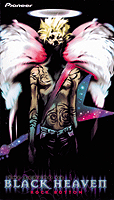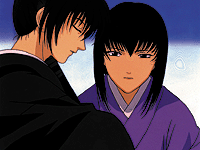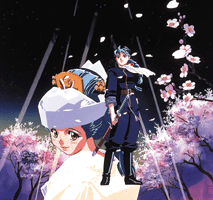Fred Patten reviews the latest anime releases including: The Legend of Black Heaven, Samurai X: Rurouni Kenshin, Virgin Fleet, Royal Space Force: The Wings of Honneamise and Sol Bianca: The Legacy.
Around 1995, Japanese animation (anime) began pouring into North America, Europe and across the globe in video form. Most of these titles were unknown outside of Japan and never covered by animation journals. Whether a title is highly popular or very obscure, a high-quality theatrical feature or a cheap and unimaginative direct-to-video release, they all look the same on a store shelf. Therefore, Animation World Magazine will regularly review several new releases (including re-releases not previously covered) that have some merit and about which our readers should know.

The Legend of Black Heaven. V.1, Rock Bottom. V.2, Space Truckin'.
TV series, 1999. Director: Yasuhito Kikuchi. V.1, 4 episodes, 100 minutes. V.2 - V.4, 3 episodes each, 75 minutes each. Price & format: $24.98 each subtitled or dubbed video; $29.98 bilingual DVD. Distributor: Pioneer. (V.3 & 4 to come.)
This 1999 Japanese prime time TV comedy is notable for two special aspects: its idealization of 1970s/'80s heavy metal music (and the work of popular guitarist Michael Schenker in particular), and a plot designed primarily for an audience a generation older than the usual children and teens.
Oji Tanaka appears to be a typical white-collar salaryman in the Japanese business world. He is actually so apathetic that he is about to be fired. In the early 1980's he was "Gabriel" Tanaka, the lead guitarist in Black Heaven, a hot Japanese band that imitated the latest sounds from such new rock gods as Michael Schenker. But he got married, and traded his dream for a steady paycheck in order to raise a family. Today his family ignores him except as a breadwinner. His wife throws out his prized guitar to make room for their child's toys.
Just as Oji's disillusion is about to become terminal, a new employee, Layla Yuki, claims to be a fan of his music. She lures him through a dimensional portal to an alternate world where Earth is losing a space war. The only hope of defeating the invaders is a new sonic weapon which needs the vibrations of Oji's unique electronic hard-rock playing. Learning that his music is still appreciated brings Oji back to life.

Black Heaven is a funky comedy packed with references to the rock and anime scenes of the early '80s. Layla's repeated weak excuses to drag Oji off to the hidden portal are interpreted by his office workers and neighbors as an illicit affair, especially since she uses sultry phrases like "the stairway to heaven" which sound like risqué double entendres. (Oji recognizes "Stairway to Heaven" as the title of a Led Zeppelin classic. All the episode titles like "Rock Bottom" are named after notable heavy metal hits.) Japanese viewers, and American fans of the 1980s' Robotech TV cartoons from Japan, will recognize the improbable concept of defeating space invaders with rock music as a pastiche of the 1982 anime TV hit in which space invaders were traumatized by the melodies of an interplanetary pop singer. The alternate-world space war subplot parodies the Japanese live-action kids' TV genre that has been Americanized as Mighty Morphin' Power Rangers. The main action centers around Oji's attempt to resurrect his dream, to get his band back together and prove that Black Heaven still swings, while avoiding the appearance of a sex scandal that could ruin his marriage and his career. His efforts not incidentally revitalize his relationship with wife Yoshiko and make him a hero to his young son Gen. ("My Dad is helping the UFO Rangers fight the Dark Nebula Demonic Army!? COOL!!!") Some of the Japanese cultural jokes will be over the heads of American viewers (the Black Heaven title is for the American market; the Japanese title is Kacho Oji, Oji the Assistant Section Head, but the popular Japanese name Oji means "prince" and he is gradually revealed as a "disguised prince among commoners"), but there is enough humor that comes through to amuse Yankees satisfactorily.
Black Heaven's most obvious theme is consciously exaggerated wish-fulfillment fantasy for an audience ready for a mid-life crisis, that would like to return to their youthful music and TV favorites and dream of a second chance at their whole future. Hard rock and 1980s anime is also still 'in' with the current teen generation, and will demonstrate to them that Dad may not be so square, after all (A Goofy Movie, anybody?). And there is enough real hard rock music (the theme song, "Cautionary Warning," by John Sykes, a rock guitarist whose group has toured Japan several times, in the original arrangement plus two new arrangements; Michael Schenker Group's "In the Arena;" and original TV rock songs to match by Hironobu Kageyama and Riyu Konaka) to please serious rock fans.
The animation quality -- okay, so it was a low-budget TV production (13 weekly episodes, July 8 - October 7, 1999). Nobody disses the Jay Ward TV cartoons for their cheap production values, do they? The two animation studios, A.I.C. (Anime International Company) and A.P.P.P. Co. (Another Push Pin Production), both do much better with larger-budget productions.

Samurai X: Rurouni Kenshin. V.1, Trust. V.2, Betrayal.
Original animation video (OAV) series, 1999. Director: Kazuhiro Furuhashi. 60 minutes each. Price & format: video $29.95 subtitled/$19.98 dubbed each; DVD bilingual $29.98 each. Distributor: A. D. Vision Films.
[This gets confusing: Samurai X is the title of the video dubbed edition, whileRurouni Kenshin is the title of the subtitled video and the DVD edition. Plus, there is a separate Rurouni Kenshin TV series which is getting a simultaneous U.S. video release from another company, Media Blasters.]
Japanese animation first gained a cult following in America for its giant robot battlefests and space adventure epics. But there are many viewers who prefer the historical dramas, which offer a genuine historical background in a setting so exotic and so unknown to non-Japanese that it might as well be on a planet far, far away. This story takes place during the traumatic collapse of the 250-year Shogunate period (1601-1868), which occurred between the visit of Commodore Perry's fleet in 1853 to open Japan forcibly to world trade, and 1868 when the emperor was restored.
Rurouni Kenshin began as an immensely popular comic book (manga) historical serial by Nobuhiro Watsuki from 1994 to 1999. It was quickly adapted as a 94-episode animated TV series, running from January 10, 1996 through September 8, 1998 (currently being released separately in America under Media Blasters' AnimeWorks video label); there was also an anime theatrical feature in December 1997. Set in 1879, it tells the adventures of a group of teens who gather around Kenshin, a rurouni (ronin; vagabond samurai) in his late twenties on a self-imposed pilgrimage of redemption. When he was just a young teen, Kenshin was the deadliest assassin of the reformers who fought the Shogunate. Disillusioned by all the killing on both sides in the name of noble ideals, he hopes to atone for his violent past.

Samurai X (the title refers to the cross-shaped scar on Kenshin's cheek) is a two-hour, four episode direct-to video series released as Rurouni Kenshin: Reminiscence in 1999. It is Kenshin's origin story, showing his violent past which was hinted at in the TV series. Kenshin bursts into the shadow civil war as an idealistic 14-year-old whose lithe dexterity is taken advantage of by the reformers to use him as a murderer of their political opponents. The first half hour episode establishes this; the following three switch to somber despair as Kenshin realizes that he is no better than the "enemies of the people" he is ordered to slay. Kenshin's failed attempt to escape into a peaceful life as a farmer, and his resolution to die in battle against the Shogun's agents, move forward with a growing inevitability which portends an unalterable fate. (Yet, since this is a prequel to the TV series, viewers are supposed to know that Kenshin will, somehow, survive.) Director Furuhashi builds an emotional impact with calm, poetic imagery such as slowly dripping blood upon snow which skillfully gets the most out of limited animation. (Production by Studio Deen.)
Royal Space Force: The Wings of Honneamise.
Theatrical feature, 1987. Director: Hiroyuki Yamaga. 125 minutes. Price & format: $29.95 DVD. Distributor: Manga Entertainment.
Royal Space Force was a milestone in Japanese animation history. A small group of young animators persuaded entertainment giant Bandai to fund their new studio's first theatrical feature; an intellectual sci-fi drama with no merchandising tie-ins. The movie bombed financially but won critical raves that established Studio Gainax's reputation. Also, the movie's video release helped demonstrate the potential of Japan's new anime video market.
The movie typifies much of anime in emphasizing art -- richly-detailed backgrounds and costumes -- and story rather than full animation. Royal Space Force in particular has stunned audiences with its elaborate setting of an alternate Earth. Rather than merely showing normal society with fictional nations or historical figures, RSF depicts a completely original civilization with unique yet plausible designs of everything from religions to clothes and household artifacts. Even the symphonic score by Ryuichi Sakamoto has an unusually sharp metallic undertone that enhances the exoticism.

Shirotsugh Lhadatt is a young sailor assigned to the Kingdom of Honneamise's tiny disaster-prone space program just as war looms. The commander is determined to orbit an astronaut before the Space Force is absorbed into the military effort. Shiro's enthusiasm at being chosen as the astronaut is tempered by the realization of all the safety testing they are bypassing. An equal worry is that the launch site is right on the border, and is sure to be captured or destroyed if fighting starts before the rocket is completed. Royal Space Force strikes a delicate balance of realistic, serious technological research; the drama of political tension, espionage and warfare; and the inspirational uplift of a young everyman's consideration of the space program's moral and social considerations (Shiro's girlfriend worries that the rocket could be used as a new weapon) and conviction of its positive benefits.

Sol Bianca: The Legacy. V.1, Lost Treasures. V.2, Separation. V.3, Going Home.
Original animation video (OAV) series, 2000. Director: HiroyukiOchi. 60 minutes each. Price each & format: $29.98 subtitled video, $24.98 dubbed video, $29.98 DVD bilingual. Distributor: Pioneer.
There is a school of thought that animated cartoons should look pretty but do not need to make much sense. Sol Bianca: The Legacy certainly plays to this philosophy. Yet its empty-headedness is unusuallyintellectual. Viewers will recognize the Alhambra in a palace on a distant planet, or that soaring holographic statues are based upon Alphonse Mucha's Art Nouveau posters. A giant maze is boastfully acknowledged to be a mechanical recreation (with deadly traps) of the levels ofDante's Divine Comedy. And where else would you find attacking space pirates dressed as though they were attending an opera?
This is a sequel of sorts to Sol Bianca, a 1990 OAV space opera from A.I.C. (Anime International Co.) about a band of sexy all-girl space pirates who steal only from despicable planetary dictators. It was a mindless Star Wars imitation, but had very nice art design by Naoyuki Onda. Ten years later, A.I.C. has upped the ante with this second Sol Bianca, a serial consisting of six half-hour episodes, two per volume. It nominally presents the same crew in a new adventure, except that the characters have different origins and relationships. What is important is that there is no longer any pretense that the story is important.

Instead, this is an artistic tour de force for Director Hiroyuki Ochi and his staff of character and mechanical designers, notably Naoyuki Onda again, Atsushi Takeuchi, Koji Watanabe, Kenji Teraoka and Nobuhito Sue, with extensive 3D CGI work by Satoshi Shimura. The emphasis is on beauty. All men are handsome, all women are lovely, and every scene looks like it is posed (i.e., not much actual animation) for a fashion magazine. The space adventure still has gaping holes in its logic, compounded by a plot that jumps forward in medias res and leaves the viewer to puzzle together the 25th(?) century interstellar background from cryptic references to "the decline since the Space Frontier Age," "the search for lost Earth" and so forth. But there are now all the nudge nudge wink wink background cultural references to Inca ruins, Spanish architecture, the literature of Thomas Mann, etc., to indicate that any lapses in the plot are not because of a lack of sophistication. Rather, the viewer is meant to appreciate the visual aspects (Ochi's skillful direction distracts the viewer from the limited animation), and the personality interplay between space pirates April, Janny, Feb, Jun and young stowaway Mayo. These are the real focus of the adventure.
As added evidence of the emphasis on the art direction, the opening credits and each preview of the next volume are edited to make an excellent music video. The DVDs also contain "Animetronic" music clips which are bonus music videos of 8 to 10 minutes.

Virgin Fleet.
Original animation video (OAV) series, 1998. Director: Masahiro Hosoda. 90-minutes. Price & format: $19.99 dubbed video; $29.99 bilingual DVD. Distributor: U.S. Manga Corps./Central Park Media.
Even minor anime titles can have points of interest. Virgin Fleet is an example of what may be building up to a new sub-genre of teen military comedies about untested all-female combat units who must prove they can fight as well as the men. What makes Virgin Fleet (originally a three half-hour OAV series) particularly interesting is its alternate-history premise.
The setting is an Earth where atomic power has not been discovered, but Japanese research into paranormal mental powers has awakened psionic energy in some humans -- but only women, and only as long as they are virgins. Fifteen years earlier, in a conflict similar to World War II, a ship of young women with this talent sunk a "federation" invasion fleet. This resulted in a cease-fire that has lasted to the present. A naval girl's academy has been opened to train new girls with psychic energy to crew a Virgin Fleet.

This is the background for a mostly silly teen farce. Japan has been at peace for so long that the academy has turned into a finishing school where giggly teens play at being sailors and navy aviators. New student Shiokaze Umino has enrolled to demonstrate she is still a virgin, to make a respectable bride for handsome Mau Sakisaka. Cadet leader Satsuki Yukimizawa, who is overly gung-ho about the fleet's military mission, is determined to force Shiokaze out. The schoolgirl catfights (with Mau as a comically inept mediator) play into the hands of naval Chief Tatsugawa, a reactionary who has been trying to persuade the government to abandon the Virgin Fleet and rebuild the Imperial Navy. The plot turns dramatic when enemy spies try to sabotage the Virgin Fleet in preparation for a reactivation of the war. Satsuki is ready to fight but she lacks enough Virgin Energy. Shiokaze has the energy, but she freezes in panic at the prospect of real danger.
I was intrigued by Virgin Fleet's background portrayal of a Japan that has rebuilt itself without the dominating cultural influence of a Western occupation. There is technical modernization in appliances and the news media, but architecture and clothing styles are closer to those of 1940s Japan. The score by Masumi Ito is modern movie-music when punching up the action scenes, but in the style of traditional Japanese music in the street scenes. Even the opening and closing theme songs by Chisa Tanabe are pseudo-1940s or 1950s Japanese pop music, before it became as heavily Westernized as in our world today. (Production by A.I.C.)
Fred Patten has written on anime for fan and professional magazines since the late 1970s.







